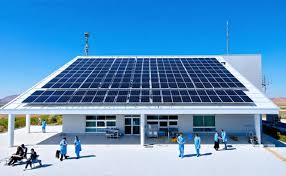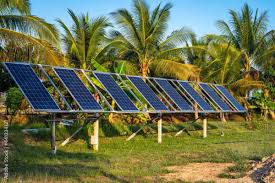5 Ways Solar Pv Can Enhance Rural Healthcare
Solar PV enhances rural healthcare: powering vaccine fridges (2–8°C, slashing spoilage from 20% to 5%), LED lights extend clinics’ evening hours by 8+, cell storage ensures 24/7 ultrasound use, and cuts diesel reliance by 70%, boosting maternal care and emergency response.
Reliable Power for Medical Refrigerators
In rural health clinics, a consistent power supply isn't just a convenience—it's a cornerstone of effective healthcare. The World Health Organization (WHO) estimates that nearly 25% of health facilities in sub-Saharan Africa have no electricity, and many more suffer from frequent, unpredictable outages. This directly compromises the $2.8 billion worth of vaccines lost globally each year due to temperature breaches. Medical refrigerators must maintain a strict temperature range, typically between 2°C and 8°C. A single outage lasting a few hours can destroy years' worth of vaccines, medications, and lab samples, rendering critical care impossible. Solar PV systems provide a definitive solution, ensuring that these vital medical assets remain viable 24/7, regardless of grid reliability.
l Core modules: Solar panels, charge controller, cell bank, inverter.
l Critical function: Maintains a constant 2°C to 8°C internal temperature.
l Primary benefit: Protects temperature-sensitive vaccines and medicines.
l System advantage: Operates independently of an unreliable main grid.
For a medium-sized medical refrigerator consuming approximately 1.5 kWh per day, a 340W solar panel can generate enough power in about 5 hours of peak sun. However, to ensure operation through the night and during periods of low sunlight, a cell bank with a usable capacity of at least 5 kWh is essential. This provides a 24 to 48-hour buffer without any solar input.
Vaccine | Storage Temperature Range | Maximum Storage Time Outside Range | Consequences of Temperature Excursion |
Pfizer-BioNTech COVID-19 | -90°C to -60°C (Ultra-Cold); 2°C to 8°C (Thawed) | 2 weeks (thawed) | Loss of potency, reduced effectiveness |
Measles, Mumps, Rubella | -50°C to +8°C | 1 hour at room temperature | Permanent damage, must be discarded |
Insulin | 2°C to 8°C (Unopened) | 28 days (opened, at room temp) | Degradation, loss of efficacy |
The cell lifespan is a key factor, typically lasting 5-7 years before needing replacement, while the solar panels themselves have a performance warranty of 25 years. This long-term reliability translates to predictable budgeting for healthcare providers, ensuring that funds can be allocated to other critical needs rather than volatile energy costs. The system's uptime reliability can exceed 99.9%, a critical metric for safeguarding public health investments.

Lighting for Evening Patient Care
Over 40% of health facilities in Sub-Saharan Africa lack reliable lighting, forcing staff to resort to kerosene lanterns or mobile phone lights for nighttime procedures. This inadequate illumination leads to a 30% reduction in outpatient visits after dark, as patients avoid traveling to poorly lit clinics. For medical staff, attempting to conduct examinations, administer medication, or assist with childbirth in low light (below 200 lux) significantly increases the risk of error. Solar-powered LED lighting systems directly address this, transforming a clinic’s operational hours and enabling a >80% improvement in diagnostic confidence during evening shifts, ensuring patient safety is not dictated by the time of day.
l Core application: Examinations, childbirth, medication administration, emergency care.
l Technology: High-lumen LED fixtures powered by dedicated solar circuits.
l Key metric: Achieving over 300 lux of illuminance in treatment areas.
l Direct impact: Enabling 24/7 operational capability for critical care.
A general ward may only need 150 lux, but for a detailed examination or suturing a wound, the recommended level jumps to >500 lux. A single 30W LED panel can produce approximately 3,000 lumens, delivering over 500 lux to a 2-meter x 2-meter examination table. This is a 400% improvement over the ~100 lux provided by a typical kerosene lamp.
A single kerosene lamp consumes roughly 1 liter of fuel per 4 hours of use, costing a clinic about $1.50 per night and producing harmful indoor air pollution. In contrast, a 30W solar LED system designed to operate for 6 hours per night has a minimal operational cost after the initial investment. The system comprises a 100W solar panel, a 50Ah deep-cycle cell, and the LED lights.
A typical clinic lighting system with a 48-hour cell backup can be installed for an upfront cost of 400−800. The LED fixtures have a lifespan of >50,000 hours, meaning they can operate for over 15 years at 10 hours per day without needing replacement.
The payback period for the solar lighting system, when compared to 2 years of kerosene expenditure, can be as short as 12-18 months. Furthermore, the presence of bright, reliable lighting increases community trust, leading to a 15-20% increase in nighttime facility utilization for deliveries and emergencies, directly improving maternal and child health outcomes. The system's mean time between failures (MTBF) for major modules exceeds 5 years, ensuring consistent care and reducing clinic operational stress.
Running Medical Devices Off-Grid
Diagnostic and therapeutic devices are the cornerstone of modern medicine, yet an estimated 30% of equipment in developing countries is out of service, with power instability being a leading cause. A centrifuge for hematocrit tests, an oxygen concentrator for a patient in respiratory distress, or an ultrasound machine for prenatal care—each requires stable, clean electricity. An unreliable grid or a diesel generator with fuel shortages can render a $15,000 ultrasound machine completely useless. Solar photovoltaic (PV) systems, specifically designed with medical-grade inverters and sufficient cell storage, transition these critical devices from sporadic use to >99% operational availability, enabling diagnoses and treatments that are otherwise impossible off-grid.
A small 8-watt pulse oximeter has minimal impact, while a 120-watt oxygen concentrator running continuously for 12 hours consumes a significant 1.44 kilowatt-hours (kWh) per day. An ultrasound machine might have a peak power draw of 250 watts but is only used intermittently, perhaps for a total of 2 hours daily, resulting in a 0.5 kWh daily consumption. Sizing a solar system begins with this detailed energy audit.
For a clinic aiming to run an oxygen concentrator (1.44 kWh/day), an ultrasound (0.5 kWh/day), and basic lighting/charging (0.5 kWh/day), the total daily energy requirement is approximately 2.44 kWh. To generate this, a solar array of around 600 watts is recommended, accounting for system losses and 4-5 peak sun hours per day. The cell bank must be oversized to guarantee operation through 48 hours of cloud cover. For a 2.44 kWh daily load, a 5 kWh usable cell capacity is a safe minimum, which typically requires a nominal 10 kWh lead-acid cell bank or a more compact 5.5 kWh lithium-ion system.
Reducing Clinic Operating Costs
Many facilities rely on expensive diesel generators, spending between 0.30 and 0.60 per kWh on electricity, which can consume 30-50% of a clinic's discretionary operational budget. In regions with grid access, power is often unreliable, leading to damaged equipment and necessitating backup generators anyway, creating a dual financial burden. This volatility directly limits the capacity to stock essential medicines, hire additional staff, or fund community health programs. A solar PV system transforms energy from a recurring, variable expense into a fixed, predictable capital investment with near-zero marginal cost for 20-25 years, enabling clinic administrators to reallocate thousands of dollars annually toward direct patient care.
A typical clinic using a 5 kVA diesel generator for 8 hours per day consumes approximately 3 liters of fuel per hour, totaling 24 liters daily. At a diesel price of 1.15 per liter ,the daily cost is 27.60, which adds up to 10,074 annually.
A solar system with a pure sine wave inverter provides clean, stable power, potentially reducing device failure rates by over 25%. Furthermore, the predictability of solar allows for precise long-term budgeting. There is no exposure to global fuel price fluctuations; the cost is capped at installation. The following table compares the 5-year Total Cost of Ownership (TCO) for a clinic relying on different power sources, assuming a 8 kWh daily energy requirement:
Power Source | Initial Cost | Fuel/Maintenance Cost (5 yrs) | Total 5-Year Cost | Notes |
Diesel Generator Only | $2,500 | $52,000 | $54,500 | High operating cost, noisy, polluting |
Unreliable Grid + Backup Generator | $3,000 | $38,000 | $41,000 | Slightly lower runtime, but still volatile |
Solar PV + Cell System | $8,500 | ~$500 (minimal maintenance) | ~$9,000 | Lowest TCO, stable, silent, zero emissions |
The $9,000+ saved annually can be redirected to critical areas. This sum could cover the annual salary for a community health worker, the cost of vaccinating 500 children, or the procurement of a continuous supply of essential antibiotics for a year. The solar system's 25-year lifespan guarantees these savings compound, creating a long-term, sustainable funding mechanism for the clinic that is independent of external energy subsidies or price shocks.

Powering Water Pumps for Sanitation
A reliable water supply is the bedrock of infection prevention and control in any healthcare setting. Yet, according to the World Health Organization, nearly 25% of healthcare facilities globally lack basic water services. In rural clinics, this often means staff and patients must collect water manually from distant sources, a time-consuming process that can require over 30 minutes per trip for a single container. This inadequate supply severely limits handwashing, sterilization of instruments, and safe childbirth practices, contributing to an estimated 840,000 deaths annually from preventable water-borne diseases.
A typical rural clinic serving 50 patients per day needs approximately 2,500 liters of water daily. To lift water from a borehole with a 40-meter static head to an overhead tank, a 600-watt solar submersible pump can move about 5,000 liters per hour under full sun. The system design is critical: an array of three 400-watt solar panels (1.2 kW total) generates sufficient power to fill a 5,000-liter storage tank in less than 2 hours of peak sunlight. This tank provides a 48-hour water reserve, ensuring supply through periods of cloudy weather. The key is to oversize the storage tank, not the solar array, as tank capacity is far more cost-effective than cell storage for water. A 1 HP (746-watt) pump might draw 8 amps at 96 volts DC, requiring a specific solar controller that maximizes energy harvest from the panels, often increasing daily water output by up to 30% compared to a direct connection.
The manual collection of 2,500 liters of water can consume 15-20 person-hours of staff time per day, effectively taking a nurse or aide away from patient care. A diesel-powered pump for the same task would consume about 2 liters of fuel daily, costing over $800 per year and requiring frequent maintenance. In contrast, a solar pumping system has no fuel costs and minimal maintenance. The following table compares the 5-year Total Cost of Ownership (TCO) for a clinic requiring 2,500 liters of water per day:
Water Pumping Method | Initial System Cost | 5-Year Operational Cost (Fuel/Labor) | Total 5-Year Cost | Reliability & Notes |
Manual Collection (Staff Time) | ~$500 (containers) | $18,000 (Value of staff time) | $18,500 | Low volume, inconsistent, high opportunity cost. |
Diesel Engine Pump | $2,000 | $4,000 (Fuel & Maintenance) | $6,000 | Noisy, polluting, volatile fuel costs. |
Solar PV Pump System | $4,500 | ~$100 (Minor maintenance) | ~$4,600 | Lowest TCO, 20+ year lifespan on panels, automated operation. |
A consistent flow enables the installation of dedicated handwashing stations with a >80% compliance rate among staff and visitors. It allows for the proper sterilization of an average of 20 surgical instruments per day in an autoclave, which itself requires a significant amount of water. The presence of ample water reduces the rate of Healthcare-Associated Infections (HAIs) by an estimated 30-50%, a critical metric for patient safety.